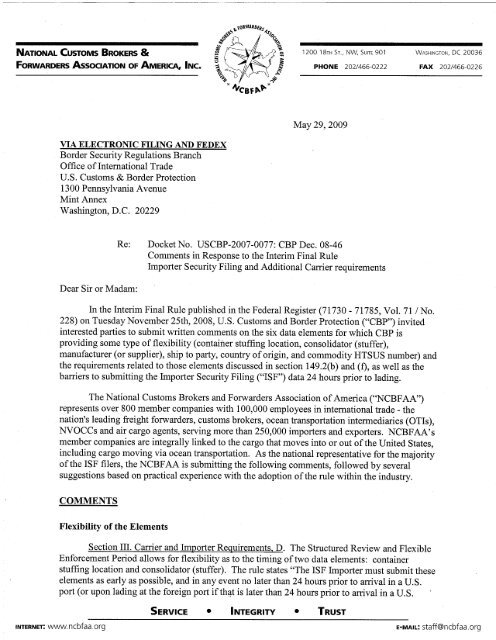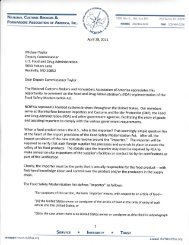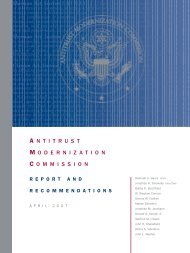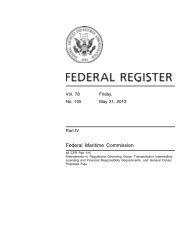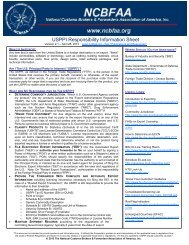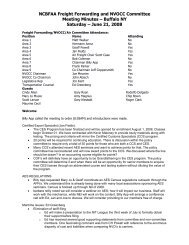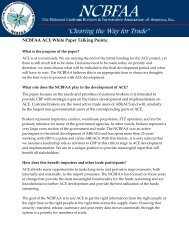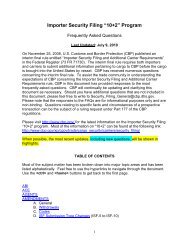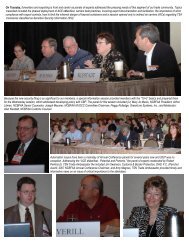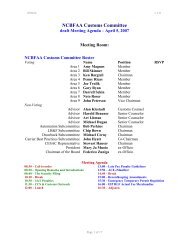letter to Customs and Border Protection (CBP) - ncbfaa
letter to Customs and Border Protection (CBP) - ncbfaa
letter to Customs and Border Protection (CBP) - ncbfaa
Create successful ePaper yourself
Turn your PDF publications into a flip-book with our unique Google optimized e-Paper software.
NATIONAL CUSTOMS BROKERS ~FORWARDERS ASSOCIATION OF AMERICA~ INC.1200 18TH ST., NW, SUITE 901PHONE 202/466-0222V~ASHINGTON, DC 20036FAX 202/466-0226VIA ELECTRONIC FILING AND FEDEX<strong>Border</strong> Security Regulations BranchOffice of International TradeU.S. Cus<strong>to</strong>ms & <strong>Border</strong> <strong>Protection</strong>1300 Pennsylvania AvenueMint AnnexWashing<strong>to</strong>n, D.C. 20229May 29, 2009Dear Sir or Madam:Re: Docket No. US<strong>CBP</strong>-2007-0077: <strong>CBP</strong> Dec. 08-46Comments in Response <strong>to</strong> the Interim Final RuleImporter Security Filing <strong>and</strong> Additional Carrier requirementsIn the Interim Final Rule published in the Federal Register (71730 - 71785, Vol. 71 / No.228) on Tuesday November 25th, 2008, U.S. Cus<strong>to</strong>ms <strong>and</strong> <strong>Border</strong> <strong>Protection</strong> ("<strong>CBP</strong>") invitedinterested parties <strong>to</strong> submit written comments on the six data elements for which <strong>CBP</strong> isproviding some type of flexibility (container stuffing location, consolida<strong>to</strong>r (stuffer),manufacturer (or supplier), ship <strong>to</strong> party, country of origin, <strong>and</strong> commodity HTSUS number) <strong>and</strong>the requirements related <strong>to</strong> those elements discussed in section 149.2(b) <strong>and</strong> (f), as well as thebarriers <strong>to</strong> submitting the Importer Security Filing ("ISF") data 24 hours prior <strong>to</strong> lading.The National Cus<strong>to</strong>ms Brokers <strong>and</strong> Forwarders Association of America ("NCBFAA")represents over 800 member companies with 100,000 employees in international trade - thenation’s leading freight forwarders, cus<strong>to</strong>ms brokers, ocean transportation intermediaries (OTIs),NVOCCs <strong>and</strong> air cargo agents, serving more than 250,000 importers <strong>and</strong> exporters. NCBFAA’smember companies are integrally linked <strong>to</strong> the cargo that moves in<strong>to</strong> or out of the United States,including cargo moving via ocean transportation. As the national representative for the majorityof the ISF tilers, the NCBFAA is submitting the following comments, followed by severalsuggestions based on practical experience with the adoption of the role within the industry.COMMENTSFlexibility of the ElementsSection III. Carrier <strong>and</strong> Importer Requirements, D. The Structured Review <strong>and</strong> FlexibleEnforcement Period allows for flexibility as <strong>to</strong> the timing of two data elements: containerstuffing location <strong>and</strong> consolida<strong>to</strong>r (stuffer). The rule states "The ISF Importer must submit theseelements as early as possible, <strong>and</strong> in any event no later than 24 hours prior <strong>to</strong> arrival in a U.S.port (or upon lading at the foreign port if that is later than 24 hours prior <strong>to</strong> arrival in a U.S.SERVICE ¯ INTEGRITY o TRUSTINTERNET." www.<strong>ncbfaa</strong>.orgE-MAIL: staff@<strong>ncbfaa</strong>.org
port)." We believe that the continued flexibility in timing of these data elements remains critical<strong>to</strong> the trade in ensuring that accurate data is transmitted for targeting purposes. In manyinstances, the filer of the ISF data is not made aware of the actual container stuffer or stuffinglocation until after the merch<strong>and</strong>ise has been laden on board the vessel. The delayed receipt ofthis data would cause an otherwise compliant ISF transmission <strong>to</strong> be filed late, unnecessarilysubjecting the ISF Importer <strong>to</strong> potential liquidated damages liability.Additionally, the Interim Final Rule provides that "four elements will be subject <strong>to</strong>flexibility as <strong>to</strong> interpretation. These elements are the Manufacturer (or supplier), Ship <strong>to</strong> party,Country of origin, <strong>and</strong> Commodity HTSUS number. There is no special timing flexibility forthese elements; they must be filed 24 hours prior <strong>to</strong> lading. However, <strong>CBP</strong> has added flexibilityby allowing ISF Importers, in their initial filing, <strong>to</strong> provide a range of acceptable responses basedon facts available <strong>to</strong> the importer at the time, in lieu of a single specific response (which maybecome known <strong>to</strong> the importer only at a later time)." The education of overseas supply chainparticipants, suppliers, <strong>and</strong> vendors is taking a significant amount of time <strong>and</strong> is especiallydifficult for those importer clients who have multiple supply chains in a myriad of countries. ISFImporters face a significant challenge in their efforts <strong>to</strong> first explain the ISF requirements <strong>to</strong> theirsupply chain partners <strong>and</strong> <strong>to</strong> then extract the necessary information in a timely manner. Weencourage <strong>CBP</strong> <strong>to</strong> maintain the flexibility of these data elements <strong>to</strong> facilitate the receipt of therequired screening data in a timely manner.In relation <strong>to</strong> the flexibility of the timing <strong>and</strong> perfection of the data elements, <strong>CBP</strong> hasrequired that the ISF Importer transmit corrections <strong>to</strong> the information as it becomes known. Theassessment of penalties as outlined in the "FAQ’s: Importer Security Filing "10+2" Document"published on the <strong>CBP</strong> website on 01/25/2009 available at(http://cbp.gov/xp/cgov/trade/cargo securitUcarriers/securit¥ filing/) under the "EnforcementMeasures" heading, Section B. Liquidated Damages, Point 1 indicates that "<strong>CBP</strong> will issueliquidated damages for $5,000 for each ISF transmission that is not timely, complete <strong>and</strong>/oraccurate." <strong>CBP</strong> has indicated that each correction or amendment <strong>to</strong> an ISF constitutes a separateISF transmission. We recommend that the assessment of liquidated damages be contemplated onthe ISF shipmer/t level, as defined by the original ISF filing, instead of on each transmission.Corrections <strong>and</strong> perfections of data that are permitted under the flexible~data elements, as well assubsequent corrections <strong>to</strong> the original transmission, should not be viewed as separate violations<strong>and</strong> should not give rise <strong>to</strong> independent liquidated damages assessments. Assessment ofliquidated damages on an individual transmission basis seems contrary <strong>to</strong> the intent of theflexibility of the data elements, <strong>and</strong> may unduly expose ISF importers <strong>to</strong> additional liability fortheir good faith attempts <strong>to</strong> comply with the rule.Visibility of Date <strong>and</strong> Time of Container LadingSection III. Carrier <strong>and</strong> Importer Requirements, C. New Importer Requirements UnderThis Interim Final Rule, codified under § 149.2 (a) <strong>and</strong> (b) (1)-(4). This section provides thatthe "interim final rule requires Importer Security Filing (ISF) Importers, as defined in theseregulations, or their agents, <strong>to</strong> transmit an Importer Security Filing <strong>to</strong> <strong>CBP</strong>, for cargo other thanforeign cargo remaining on board (FROB), no later than 24 hours before cargo is laden aboard avessel destined <strong>to</strong> the United States." Similarly, in Section iII. Carrier <strong>and</strong> ImporterRequirements, B. New Carrier Requirements, it is indicated that "Carriers must submit a CSMwhen any of the required events occurs if the carrier creates or collects a CSM in its equipment ~INTERNET: www.<strong>ncbfaa</strong>.org2SERVICE ¯ INTEGRITY ¯ TRUSTE-MAIL." staff@<strong>ncbfaa</strong>.orc
tracking system reporting that event. Carriers are not required <strong>to</strong> create or collect any CSM dataother than those which the carrier already creates or collects on its own <strong>and</strong> maintains in itselectronic equipment tracking system."It has become evident <strong>to</strong> the trade that not all carriers electronically create or collect thecontainer lading date <strong>and</strong> time. As such this information is neither visible <strong>to</strong> the trade, nor <strong>to</strong><strong>CBP</strong> for an accurate measurement of compliance with Section III, C. We believe that this ineffect creates a barrier <strong>to</strong> submitting an accurate ISF data 24 hours prior <strong>to</strong> lading, as this timeelement is neither published nor known <strong>to</strong> parties in a normal commercial environment. Wesuggest that compliance with the rule be measured against a known collected data element <strong>to</strong>allow for requisite transparency, predictability <strong>and</strong> reliability for enforcement.Availability of the Bill of Lading Information <strong>to</strong> the Lowest AMS LevelUnder Section III. Carrier <strong>and</strong> Importer Requirements, <strong>and</strong> codified in § 149.3 (a), the billof lading is required <strong>to</strong> be filed at the lowest level. Due <strong>to</strong> the commercial structure of the supplychain, the lowest bill of lading is often hard <strong>to</strong> obtain for both tilers <strong>and</strong> importers within thetime constraints for compliance with the rule. Matching the ISF filing <strong>to</strong> the house bill of ladingnumber continues <strong>to</strong> be a major challenge for ISF tilers. While the program outlined is termed"10+2," a house bill of lading element will be critical for the ISF filer in every case where that isthe lowest bill, <strong>and</strong> for <strong>CBP</strong> <strong>to</strong> match the data elements from two data sources. As the ISF filermay be reliant on the vessel opera<strong>to</strong>r, NVOCC, forwarder, consolida<strong>to</strong>r, shipper, or some othersource for this information, if the information is provided late or it is incorrect, it is beyond thecontrol of the filer <strong>and</strong> the importer. This situation is often paralleled when there is no house bill<strong>and</strong> the NVOCC does not provide bill of lading numbers more than 24 hours prior <strong>to</strong> lading. Theunavailability of the (house) bill of ladingnumber in advance of the ISF filing deadline presentsa barrier <strong>to</strong> submitting the ISF 24 hours prior <strong>to</strong> lading. We recommend that there be flexibilityof this data for a time period beyond the initial date of January 26, 2010 <strong>to</strong> mitigate furtherproblems with implementation <strong>and</strong> <strong>to</strong> ensure a continued smooth transition.SUGGESTIONS<strong>CBP</strong> Analysis of FeasibilityThe Federal Register Notice also indicated that as part of the analysis of the final rule"<strong>CBP</strong> may gather information by conducting reviews of particular importers <strong>to</strong> determinewhether submission of all 10 data elements 24 hours prior <strong>to</strong> lading was in fact feasible <strong>and</strong>, ifnot, what barriers the importer encountered. The structured review will cover a range ofenterprises, from small <strong>to</strong> large, <strong>and</strong> will include both integrated <strong>and</strong> nonintegrated supplychains." If a review of this nature has been undertaken, we encourage <strong>CBP</strong> <strong>to</strong> share the results ofthis review with the trade for informational purposes highlighting best practices where found,while maintaining the confidentiality of the participants.ISF Filer DefinitionUnder the Interim Final Rule, an ISF Filer can be any person who has a power of at<strong>to</strong>rney<strong>and</strong> access <strong>to</strong> submit data through the AMS or ABI systems. In order <strong>to</strong> be eligible <strong>to</strong> submitINTERNET: www.<strong>ncbfaa</strong>.orgSERVICE " I NT~GRITY " TRUST ,E-MAIL: staff@<strong>ncbfaa</strong>.org
data through the AMS system, a filer must have an international carriers bond. In order <strong>to</strong>submit entry data through the ABI system, the filer must be an importer of record (with an entrybond), or a Cus<strong>to</strong>ms Broker who is a U.S. person, licensed by <strong>CBP</strong>, <strong>and</strong> subject <strong>to</strong> the stricturesof U.S. laws. The Interim Final Rule indicated that access <strong>to</strong> ABI would be broadened <strong>to</strong> permi<strong>to</strong>thers <strong>to</strong> have access <strong>to</strong> this data system. We would submit that in exp<strong>and</strong>ing access <strong>to</strong> thissystem that <strong>CBP</strong> should keep in mind the purpose of the 10+2 program is <strong>to</strong> ultimately improvenational security through better cargo screening. We believe that ABI access should not beopened <strong>to</strong> any person over whom <strong>CBP</strong> does not have direct jurisdiction or who is not subject <strong>to</strong>the jurisdiction of the U.S. courts.Progress ReportsWhile we applaud <strong>CBP</strong>’s efforts in issuing progress reports <strong>to</strong> ISF Filers, we would like<strong>to</strong> suggest that <strong>CBP</strong> provide additional details in these reports <strong>to</strong> permit the ISF Filers <strong>to</strong> reviewspecific transactions for identified issues. Currently, the progress reports do not list the ISFtransaction or the bill of lading numbers that were filed late, rejected, etc. Thus, there is limitedopportunity for ISF Filers <strong>to</strong> address the issues or problems that <strong>CBP</strong> has found. In order <strong>to</strong>make this a meaningful exercise, future progress reports should identify the problematic ISF byISF transaction number as well as indicate the reason that the ISF was found <strong>to</strong> be unacceptable.If possible, these reports should be made available in popular application formats, such as Excel,or in comma delimited files that can be reformatted for ease of data manipulation. This wouldpermit the ISF Filers <strong>to</strong> share these results with the true party in interest, the ISF Importer, <strong>and</strong>enable both parties <strong>to</strong> take measures <strong>to</strong> alleviate any underlying issues.Bond GuidelinesIt was our hope that the Bond Guidelines, Single Entry Bond processes, <strong>and</strong> LiquidatedDamages Mitigation Guidelines would be published or otherwise released <strong>to</strong> the trade before thedeadline for comments was due. It is our underst<strong>and</strong>ing that these elements are still beingdeveloped by <strong>CBP</strong> <strong>and</strong> waiting publication <strong>to</strong> the trade. We would suggest that an additionalcomment period be provided for these guidelines once released.The NCBFAA is appreciative of the opportunity <strong>to</strong> file comments on the ImporterSecurity Filing program <strong>and</strong> we look forward <strong>to</strong> further opportunities <strong>to</strong> support <strong>CBP</strong> in thecontinued development <strong>and</strong> implementation of this program.Sincerely,NATIONAL CUSTOMS BROKERS &FORWARDERS ASSOCIATION OFAMERICA408689 1Alan R. KlestadtCus<strong>to</strong>ms CounselINTERNE’r." www.<strong>ncbfaa</strong>.orgSERVICE INTEGRITY ¯ TRUSTE-MAIL." staff@<strong>ncbfaa</strong>.org


